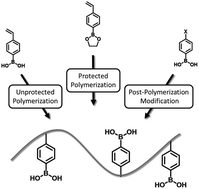Synthesis and polymerization of boronic acid containing monomers
Abstract
Boronic acid decorated copolymers have gathered significant interest in recent years. These (co)polymers are well-known for their saccharide responsive properties commonly applied in polymeric glucose sensors, cell capture and enzymatic inhibition. Despite this wide variety of applications, boronic acid containing monomers and resulting (co)polymers are also known for their notoriously difficult synthesis and purification. This review provides a condensed overview of the different synthetic pathways that have been reported for both monomer and (co)polymer synthesis. The first part of this review will focus on the synthesis of different boronic acid containing monomers bearing various polymerizable groups including (meth)acrylates, (meth)acrylamides and styrenics. These monomers show a wide variety in synthetic complexity but also in the Lewis acidity of the boronic acid moiety, which is of vital importance for success of the desired application. The second part will then discuss the main approaches for the (co)polymerization of these monomers divided into three groups, namely polymerization of unprotected boronic acid monomers, polymerization of protected boronate ester monomers and finally boronic acid incorporation through post-polymerization modification reactions. This review will complement the already numerous application-focused papers and provide a comprehensive overview of the currently used synthetic methodologies as guideline for boronic acid-containing (co)polymer research.

- This article is part of the themed collection: Polymer Chemistry Lectureship Winners

 Please wait while we load your content...
Please wait while we load your content...